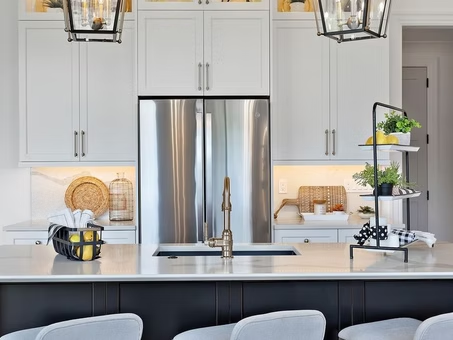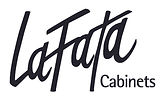Unlocking Global Trade Compliance: How to Choose the Latest Kitchen Cabinet Colors for Export Success
In today's rapidly evolving global market, selecting the right products for export is crucial for businesses aiming to thrive in international trade. Among various factors influencing success, the aesthetic appeal of kitchen cabinets plays a significant role. The Latest Kitchen Cabinet Colors not only reflect contemporary design trends but also cater to diverse consumer preferences across different regions. As international buyers become more discerning, understanding these color trends is essential for manufacturers and exporters looking to capture attention and drive sales.
Moreover, compliance with global trade regulations is equally important, as it can impact the entire exporting process. By aligning product offerings with the Latest Kitchen Cabinet Colors that resonate with target markets while ensuring adherence to trade compliance standards, companies can unlock new opportunities and mitigate risks. This blog explores how to effectively navigate the complexities of global trade, focusing on the strategic selection of kitchen cabinet colors that can enhance export success while maintaining compliance with industry standards.

Understanding the Importance of Trade Compliance in Exporting Kitchen Cabinets
In the world of exporting kitchen cabinets, trade compliance is not just a regulatory hurdle but a critical factor for success. According to a report by the International Trade Administration, over 30% of small to medium-sized businesses (SMBs) face challenges due to compliance issues when entering international markets. This underscores the importance of understanding the laws and regulations that govern trade in various jurisdictions. Ensuring that kitchen cabinets meet the necessary compliance standards not only mitigates the risk of costly delays and fines but also enhances market competitiveness. For example, the United States imposes stringent standards under the American National Standards Institute (ANSI) for materials used in cabinetry, requiring manufacturers to stay updated with any changes. Failure to comply can lead to significant setbacks, as some companies have reported losses exceeding $200,000 due to non-compliance penalties. Moreover, staying informed about trade agreements and tariffs can influence color selections and design trends. A comprehensive analysis by the National Kitchen & Bath Association revealed that exports of kitchen cabinets have risen by 15% in the last year, reflecting a growing demand for innovative designs and colors. Adapting to these trends while ensuring compliance can significantly enhance a company's export prospects, creating a harmonious balance between aesthetic appeal and regulatory adherence.

Current Trends in Kitchen Cabinet Colors that Appeal to Global Markets
In today's global marketplace, selecting the right kitchen cabinet colors is crucial for manufacturers aiming to appeal to diverse consumers. Current trends show that warm neutrals and pastel hues are gaining popularity internationally, creating a fresh and inviting atmosphere in any kitchen. These colors not only enhance the aesthetics of the space but also cater to a growing preference for minimalistic and sustainable design. Manufacturers who stay updated on these trends can better position their products for export success, tapping into the preferences of evolving global markets.
Moreover, as the home decor market continues to expand, the demand for stylish yet functional kitchen storage solutions is on the rise. Products like jars, containers, and cabinet organizers are increasingly sought after as consumers prioritize organization alongside style. By incorporating trending cabinet colors with innovative storage solutions, brands can create cohesive and appealing kitchen designs that resonate with potential buyers. This strategy not only boosts sale potential but also strengthens a brand's global presence amidst fierce competition.
Ultimately, understanding the interplay between color trends and consumer needs is essential for businesses looking to succeed in the international kitchen market. By aligning product offerings with current market demands, companies can unlock new opportunities and encourage greater investment in their unique kitchen cabinet designs.

How to Research Regulatory Requirements for Exporting Kitchen Cabinets
When exporting kitchen cabinets, understanding regulatory requirements is crucial to ensure compliance and success in the global market. As the Asia-Pacific plywood market gains momentum, projected to reach USD 80.82 billion by 2034 with a compound annual growth rate (CAGR) of 6.60%, it highlights an increasing demand for furniture, including kitchen cabinets. This surge is driven by the need for versatile and cost-effective solutions in modern households. Therefore, manufacturers need to stay abreast of the regulatory landscape to capitalize on this growing market.
To successfully navigate the export market, companies should research the specific regulatory requirements of their target countries. This includes understanding certification needs, safety regulations, and material standards that may affect the export process. In 2024 alone, exports of Vietnam's wood products experienced a remarkable 21.5% increase year-on-year, amounting to $7 billion in the first eight months. Such statistics not only enhance the prospects for kitchen cabinet manufacturers but also emphasize the importance of regulatory compliance in sustaining growth.
Moreover, staying updated on compliance requirements also allows businesses to better anticipate market trends. As consumer preferences evolve towards eco-friendly and sustainable products, aligning with regulations that reflect these values can significantly improve a company's reputation and marketability. Therefore, leveraging research on regulatory requirements will not only ensure compliance but also drive success in the competitive kitchen cabinet export sector.

Tips for Selecting Colors that Enhance Appeal and Meet Compliance Standards
Choosing the right colors for kitchen cabinets can significantly impact both market appeal and compliance with global trade standards. When selecting colors, it’s essential to consider the trends in various markets while ensuring that the finishes meet the regulatory requirements. For example, VOC (volatile organic compounds) limits can vary by country, so opting for low-VOC paints and stains not only enhances aesthetic appeal but also aligns with international environmental standards.
Furthermore, cultural preferences play a crucial role in color selection across different regions. A color that is popular in the United States may not resonate the same way in European or Asian markets. Researching regional color trends and incorporating local cultural insights can lead to better customer acceptance. Bright colors might attract attention in one market, while muted tones could be favored in another. Therefore, a thorough analysis of both aesthetic qualities and compliance requirements will ensure your kitchen cabinets stand out in the competitive global market.
Finally, working with reliable suppliers who understand local regulations and trends can streamline the process of color selection. Collaborating with manufacturers that specialize in compliant materials can help you navigate potential pitfalls in export and ensure that your products are not only visually appealing but also market-ready. By integrating these considerations into your design process, you can optimize the success of kitchen cabinetry exports on a global scale.
Building a Strategy for Marketing Compliant Kitchen Cabinets Internationally
As international markets continue to expand, the importance of compliance in the kitchen cabinet industry cannot be overstated. Building a strategy for marketing compliant kitchen cabinets internationally requires a deep understanding of both regulatory requirements and customer preferences. According to a recent report from the International Trade Administration, global demand for kitchen and bath cabinets is projected to reach $97 billion by 2027, with significant growth opportunities in emerging markets. This underscores the necessity of aligning product offerings with local regulations and aesthetic trends.
To effectively market compliant kitchen cabinets, manufacturers must first navigate the labyrinth of international standards and certifications. For instance, compliance with the European Union’s CE marking and the United States’ ANSI/KCMA certification is crucial for market entry. Furthermore, a study by the National Kitchen and Bath Association indicated that 45% of consumers prioritize eco-friendly products, emphasizing the need for sustainable materials that meet compliance standards. This not only enhances marketability but also aligns with growing consumer demands for environmentally responsible products.
In terms of design, staying abreast of the latest color trends is paramount. Research by Pantone highlights that color plays a significant role in consumer purchasing decisions, with 90% of buyers making decisions based on visual appeal. Therefore, incorporating trending colors that comply with safety and environmental regulations can provide a competitive edge. By balancing compliance with aesthetic appeal, manufacturers can successfully position their kitchen cabinets in diverse markets, driving export success while adhering to stringent regulations.


Fall into Function: How LaFata Cabinets Prepares Your Kitchen for the Cozy Season


Back-to-School Kitchen Refresh: How LaFata Cabinets Can Help You Stay Organized This Fall



